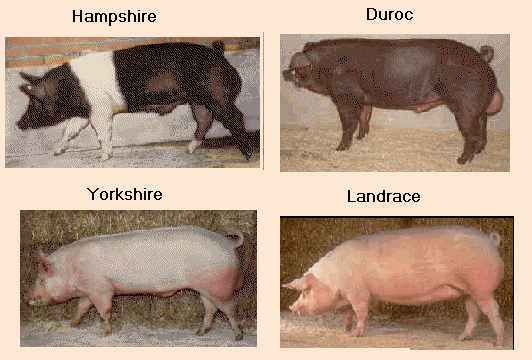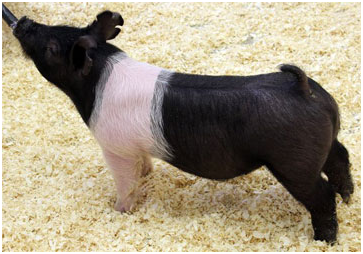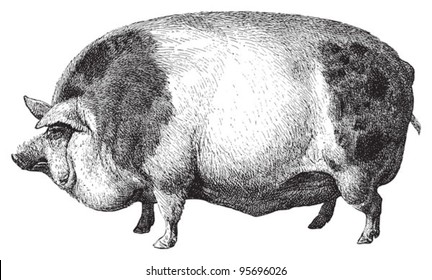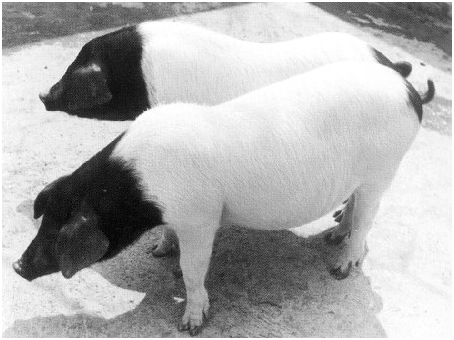博文
猪年再谈金华火腿
|||
猪年再谈金华火腿
李兆良
2019.2.5
几年前,写过一篇文章谈美国的火腿与中国金华火腿的关系。最近找到一些新材料,贴在这里。下面一些观察,联系起来,就是很好的证据链。
中国是最早驯化猪的国家之一,是没有疑问的。另一起源可能是西亚,但是缺乏确实考古证据。
欧洲人很晚才养猪,中世纪都是猎野猪。欧洲的猪是从西亚输入的,可能是中国的猪种通过西亚进入欧洲。亚洲猪是18-19世纪才进入欧洲。
美国最有名的火腿是做Virginia Ham的Hampshire猪。Hampshire种据说是英国种,但是没有确实培育年代的证据。Hampshire猪与做金华火腿的义乌猪是唯一有肩膀到前足一段白色斑带的猪种。
1779年, Capt. Mallory Todd, 在百慕大经商 ,据说从百慕大带回猪,成立了 Smithfield 的火腿工厂。出口到英国。最早用的猪全部是两头乌,传说是西班牙人留下的。但是西班牙没有两头乌。西班牙最出名的是 jamón ibérico 腌肉,用的猪没有白斑带。
白色斑纹是显性基因控制的,没有白色斑带的猪不可能培育成有斑带的猪。
白色斑带可以有不同的变异,宽度有变化。
中国金华火腿的美味是因为猪种和制作过程与发酵的菌种。制作金华火腿的义乌“两头乌”是特别的种,猪身白色,头与臀部黑色,所以称为两头乌,已经有1600年历史。
中国的义乌猪20世纪才引入中国其他地方。可是,19世纪,美国最早的猪种Hampshire猪却带有白斑带。唯一可能是来自中国猪,而且是早于义乌猪在中国传播到其他省的历史。如果亚洲猪种在18-19世纪才到达欧洲,而美洲的火腿研制工艺已经成型。唯一可能是更早有人带来美洲。英国的Hampshire猪唯一可能是从美洲带回去,而不是从英国到美洲。
最早出现类似金华火腿的Virginia州,隔河就是第一个英国在美洲的殖民地Jamestown。
Jamstown出土了中国明代民窑青花碗,不是中国外销瓷,碗也不是欧洲人的食具。出土文物还有竹筒,是中国人放筷子,毛笔的容器,美洲没有原生竹子。
阿拉斯加出土过从明到清的中国铜钱。http://www.alaskaanthropology.org/wp-content/uploads/2017/08/akanth-articles_385_v10_n12_Mooney-Kristensen-Walde.pdf 阿拉斯加出土永乐通宝的Beaver Creek (Yukon), 同时也出土了猪骨头。阿拉斯加是没有猪的。这块与永乐通宝同时出土的猪骨头证明了它的年代。(见 《宣德金牌启示录》,联经出版社,2013。 293页)
猪的基因是中国到达美洲更早的证据。加上其他的证据,结论是:明代中国人在英国人在美洲建立第一个殖民地之前,就在美洲定居。带来火腿和制作金华火腿的义乌猪种,在美国培育,后来被带回英国。
Hampshire猪的特点是背上到肚皮的白带比较窄,宽度不一,从很窄到很宽都有。Smithfield 最早的火腿之用两头乌制作。

欧洲猪的不同类型。



Hampshire猪有不同宽度的白斑带


早期的Hampshire猪,白色条纹比较宽。后来才变窄。
金华火腿的原料 - 义乌两头乌, 白斑带很宽。
附录:
金华火腿与美国的联想
李兆良 科学网(2014-8-22 14:39)
这篇文章前面是背景,最後才是主题。
弗吉尼亚有一个小镇,现在天下闻名。镇上彩绘猪雕像点缀着街道,行人道的砖上刻着它的宣传口号:“Hams, History, and Hospitality” (火腿,历史与好客),象征着世界上最大的生猪生产国(中国)与美国最出名的火腿公司合并。
2013年5月,中国的食品公司以47亿美元收购史密斯菲尔德食品(Smithfield Foods)的消息,引起世界轰动。美国有些政府官员认为是中国食品“入侵”美国,搅乱美国食品质量,有些觉得美国这老字号卖给中国,有失体面,极力阻止。但是,这些阻挠无力回天,2013年9月26日,协议达成,中国双汇集团公司正式兼并了历史悠久的史密斯菲尔德食品公司,后者行销12个国家,拥有员工46,000人。这宗合并,结束了超过200年的家族企业历史。
这家公司生产火腿的工艺,早在1780年代由一位船长马洛里·托德(Mallory Todd,1742-1817)开始。他与百慕大有生意来往,专门向英国出口火腿。他拥有良种猪,以花生做饲料,还有良港出口。注意,美国是新兴的国家,却向老殖民者国家输出火腿。这是什么火腿?
纽约是美国的美食中心,世界各国的食品原料都可以买到。世界上有成千上万的火腿种类,光是西班牙,意大利就有几百种以上。但是,高级饭馆的厨子,只认定史密斯菲尔德火腿为金华火腿唯一替代品。为什么要用史密斯菲尔德火腿?
美洲原来是没有猪的,猪都是从外面引进。中国是最早驯化猪的国家,8000年前,中国人就餋养猪,用猪陪葬,有玉猪龙的图腾。
美国史密斯菲尔德火腿有严格食品商标注册管制,不能随便那一家都生产。下面是食品药物局的定义:
“真正的史密斯菲尔德火腿现定义为火腿加工,处理,熏,年龄,受长期用干盐腌制,陈化6个月以上期限;6个月内开始发绿色霉,所有这些腌制,加工,处理,烟薰,固化和老化工艺要在弗吉尼亚州史密斯菲尔德小镇的企业范围内进行。”
为什么所有加工要在这镇的工厂进行?因为只有这样才保证霉菌的纯净性。霉菌代代繁殖,有排他性,不易感染其他菌种。金华火腿与其他火腿的气味特征,正是霉菌的作用。美国火腿锁定在这小镇生产,一来保证霉菌不外流,二来不受外来菌侵入。离开到别的地方,就不能保证。其他欧洲的火腿也是以产地做商标,工艺也局限在小作坊里。
火腿的美味,决定因素是猪种,制备方法,特别是发酵用到真菌。欧洲的火腿,散发的气味是高醛类,金华火腿中含有丰富的烷烃和烯烃。
金华猪是中国猪的地方品种,称“两头乌”,产于浙江东阳、义乌、金华等地。两头乌的头与股是黑色的。肩背上有一道白色,直透腹部。金华地区养猪历史,考古可以追溯到西晋(公元265-316年)陶猪和陶猪圈,有起码1600年的历史。金华两头乌,也叫“中国熊猫猪”,被农业部列入《国家级畜禽品种资源保护名录》。根据中国的报道,这种猪到1960年代,才繁殖到全浙江省和其他地方。金华猪有两种两头乌:老鼠头,和寿字头。

金华两头乌猪种
有一本专门讲述这家美国火腿公司的书:
PatrickEvans-Hylton, Smithfield: Ham Capital of the World. 2004
里面展示一张1951年的照片,他们用的猪也是头与尾部黑色,中间白色。美国公司的猪属于老鼠头,头长形,咀比较尖。(此书受著作权保护,不能上传图片)今天美国公司用到猪已经比较杂,不纯是两头乌了。
假如1960年,中国其他省份还没有这种猪,1951年的两头乌,怎么来美国?
有一则新闻,证明史密斯菲尔德火腿的闻名比1951年更久。1931年,一封署名“广信和”的信,广信来可能是店铺的名字,信从波士顿寄出,发到这家弗吉尼亚的火腿公司,要订购六条火腿。当时的中文信,没人看懂,结果花了一段时间,才找到附近开洗衣店的华人翻译。1931年,美国州际公路系统尚未启动。从波士顿送信到弗吉尼亚要很长时间,运送火腿到波士顿也必然是一项艰巨任务。然而,在波士顿的中国人坚持要买弗吉尼亚火腿。这是一个不寻常的请求。这宗趣事成了全国性新闻。
以上是背景。讲了半天,想说什么?
史密斯菲尔德这小镇,离开英国在美洲的第一殖民地詹姆斯顿(Jamestown)只有一河之隔,今天有小渡轮通行,只需15分钟。上文提到詹姆斯顿出土了明代早期的青花民窑碗,在第一殖民地的最下文化层,考古人员称为“地窖”。我怀疑是英国人之前,明代人就在当地聚居,用碗吃饭,用竹筒放筷子,所谓“地窖”是英国人来以前的文化层。(见《青花民窑碗在美洲第一殖民地出土》一文)
史密斯菲尔德镇邻近,一位居民在院子里捡到一片中国青花瓷片,上面是汉代砖画的人物故事,带有帝冠的人物,后面跟着拿尘拂的臣子。因为瓷片太小,无法辨认是什么故事。但是,可以肯定,这种图案不是欧洲人能欣赏的外销瓷。这又是明代人带来瓷器的另一可能。
http://activerain.trulia.com/blogsview/3033291/never-know-what-you-ll-find-in-your-backyard
金华火腿与史密斯菲尔德火腿的风味如此相似,与猪种、霉菌和炮制方法有关。是谁给这些美国人带来工艺?1950年以前,美国火腿公司用的是否两头乌?为什么其他欧洲殖民者都没有学到,光是在这小镇出现?这种火腿的出现与詹姆斯顿如此近,有没有关系?
创始人经商的百慕大,也有两头乌的猪,不晓得何时引入。如果金华的两头乌猪种在1780年代就在美洲落户,那是美国立国不久,清朝还没有与美国建立关系,那就更值得探讨了。即使以1950年算,金华猪还没有出浙江省,反而来了美国,不奇怪吗?
弗吉尼亚的火腿与加拿大育空地区伴随永乐通宝出土的猪骨头(见《美洲出土永乐通宝》一文),有没有关系?明代,金华火腿产量已经达十多万只。会不会是船员带来的猪和火腿?虽然郑和是穆斯林,他对宗教很宽容,船上会不会有猪肉,甚至养猪?
我还不能肯定詹姆斯顿是明代人曾经居住的点,但是,明初的民窑碗出现是很特殊的现象。附近的猪与火腿,是否明代人带来的?这一切都是谜,等待解答。历史拼图刚刚开始。
附录: 下面是亚洲猪如何进入欧洲的论文。
Historical records and molecular evidence indicate that Asian pigs were introduced into Europe during the 18th and early 19th centuries (Giuffra et al., 2000; Kijas et al., 2001a). https://pdfs.semanticscholar.org/3af8/77065f3313f6150e0f64252c4a8a30afdf9b.pdf
Giuffra, E., Evans, G., Tornsten, A., Wales, R., Day, A., Looft, H., Plastow, G. & Andersson, L. 1999. The Belt mutation in pigs is an allele at the Dominant white (I/KIT) locus. Mammalian Genome 10, 1132-1136.
Giuffra, E., Kijas, J.M., Amarger, V., Carlborg, O., Jeon, J.T. & Andersson, L. 2000. The origin of the domestic pig: independent domestication and subsequent introgression. Genetics 154, 1785-1791.
Pig coat colour genetics Domestication of pigs has occurred independently from Wild Boar subspecies in Europe and Asia. Historical records and molecular evidence indicate that Asian pigs were introduced into Europe during the 18th and early 19th centuries (Giuffra et al., 2000; Kijas et al., 2001a). There are several varieties of coat colour phenotypes in domesticated pigs. Most of the European breeds, such as Large White and the different Landrace pigs have a white coat colour, while the uniform black coat is the most common type in breeds from China (Legault, 1998). The main genes in pig coat colour genetics, controlling the relative amounts of melanin, eumelanin (black/brown) and phaeomelanin (yellow/red), have also been identified as the extension and agouti loci. In a variety of mammals, dominant alleles at the extension act to produce uniform black coat colour, whereas recessive alleles at this locus extend the amount of red/yellow pigment. Dominant alleles at the agouti, on the other hand, cause a yellow coat whereas the homozygosity for the bottom recessive allele is associated with a uniform black coat (Jackson, 1997). The uniform black colour in pigs is caused by mutations in the extension locus, probably resulting in constitutively active melanocortin receptor 1 (Kijas et al., 1998). There are other MC1R alleles associated with wild-type, black spotting and uniform red coat colour, the latter being probably caused by a disruption of MC1R function (Kijas et al., 1998; Kijas et al., 2001b). Several additional loci affecting coat colour in pigs have been mapped recently by whole-genome scan (Hirooka et al., 2002). During this study additional loci affecting white and black phenotypes were located, one of them possibly representing the porcine equivalent to the KIT ligand called MGF. Dominant white coat colour in pigs Already in 1906, Spillman concluded that the white coat colour in domestic pigs is a dominant trait. Since then, the potential cause for white coat in domestic pigs has been unravelled primarily using an intercross between Large White (I/I) and Wild Boar (i/i) pigs, carried out in Uppsala. First it was shown that the responsible gene is located on pig chromosome 8 and KIT gene was proposed as a potential candidate gene (Johansson et al., 1992). KIT encodes a mast/stem cell growth factor receptor, a key signal-transducing receptor in stem cell systems feeding into multiple lineages such as haematopoietic cells, germ cells, melanocytes, intestinal pacemaker cells and neuronal cells (reviewed in Bernstein et al., 1990; Broudy, 1997). Therefore, the dominant white phenotype in pigs, being due to a mutation in KIT that leads to lack of melanocytes in the skin, is consistent. Mutations in this gene also cause pigmentation disorders in mice, called Dominant white spotting/W (Chabot et al., 1988; Geissler, Ryan & Housman, 1988), and in humans, called piebald trait (Fleischman et al., 1991; Giebel & Spritz, 1991). In the mouse, loss-of-function mutations are associated with limited white spotting in heterozygotes, but they are often lethal or sublethal in the homozygous condition due to their effects on haematopoiesis (Fleischman & Mintz, 1979; Waskow et al., 2002). 10 In 1996 Johansson Moller and others presented genetic data demonstrating that the KIT gene in white pigs is duplicated. Furthermore, in 1998, the cause for dominant white phenotype in pigs was being presented as two mutations in the KIT gene – one gene duplication associated with a partially dominant phenotype and a splice mutation in one of the copies, leading to the fully dominant allele (Marklund et al., 1998). The splice mutation is a G to A substitution in the first nucleotide of intron 17 leading to skipping of exon 17. Exon 17 is composed of 123 bp and the mutation is thus an in-frame mutation deleting 41 amino acids from the protein. Those 41 amino acids are part of a highly conserved region in tyrosine kinases, comprising the catalytic loop and part of the activation loop (Hubbard et al., 1994). In contrast to the duplication, considered to be a regulatory mutation, the splice mutation is expected to cause a receptor with impaired or absent tyrosine kinase activity. But on the other hand, the existence of KIT duplication in domestic pigs allows the expression of at least one normal KIT receptor per chromosome, which is apparently sufficient to avoid severe pleiotropic effects on the tissues. Another common phenotype in domesticated pigs, associated with KIT locus, is a white belt. It is a dominant phenotype and may occur against a solid black (Hampshire) or red background (Bavarian Landschwein). Many mouse mutants display a white belt of variable width and position across the body, for instance patch and rump-white. It is known that patched phenotype in mice is caused by a deletion located ~180 kb upstream of KIT gene and rump-white is caused by a large inversion involving the same region. In pigs, the locus responsible for belted phenotype has been mapped to chromosome 8, which harbours the KIT gene. Therefore, the belt mutation is probably caused by a regulatory mutation affecting KIT expression (Giuffra et al., 1999). Gene duplications in mammalian genomes Large segmental duplications are very common in mammalian genomes. These duplications are abundant (5% of the genome), span large genomic distances (1- 100 kb) and can have very high sequence identity (95-100%) (Eichler, 2001; Bailey et al., 2002). The high level of sequence identity provides an ample substrate for recombination events. Furthermore, nearly identical sequence copies in the genome created by duplications may lead to large-scale chromosomal rearrangements, such as deletions, inversions, translocations and additional duplications. The duplications can harbour large pieces of genetic material and contain both high-copy number repeats and gene sequences with exon-intron structures. An important feature of duplications is that if they harbour coding sequences, they may not include the whole coding region and regulatory elements of a gene. It has become apparent though, that many duplicated segments are expressed, although the transcripts frequently show tissue specific transcription pattern (germline, fetal, cancerous), contain premature stop codons and are non-functional (Horvath et al., 2001). Several of such transcripts are chimeric, incorporating exons from different 11 genes, which raises the possibility of a mechanism akin to exon shuffling. Therefore, such chromosomal rearrangements as duplications are considered as exclusive contributors to the origin of reproductive isolation and the formation of new species (Lynch, 2002). Moreover, it has been proposed that imprinting may originally have evolved on a simple basis of dosage compensation required for some duplicated genes or chromosomes (Walter & Paulsen, 2003). This indicates that duplications may play an even more important role in the development of genomes than just gene innovation and speciation. The distribution of duplication events on human chromosomes seems nonuniform and detailed analysis has revealed that larger blocks of duplicated material are, in fact, composed of smaller units of modules of duplications. There are several potential explanations to duplications being more abundant in subtelomeric and perisentromeric regions. One of them relies on their lower gene density, showing a greater tolerance of these regions for the incorporation of new genetic material without adverse effects to the organism. However, there are other parts of chromosomes that are devoid of genes and yet show no increase in segmental duplication (Horvath et al., 2001). Another explanation to duplicated segments being positioned near centromeres could be a simple suppression of recombination in this region, resulting in a slower deletion of new genetic material. Segmental duplications in human have been indicated as one type of chromosomal rearrangements causing genetic diseases. It has been estimated that 1 in every 1000 human births has a duplication-mediated germline rearrangement. For instance, human cytochromes and chemokines are known to have interindividual and interethnic variabilities in copy numbers. Since cytochromes are enzymes involved in metabolism of endogenous and exogenous compounds, the variability in copy number leads to differences in effects and toxicities of many drugs (antidepressants, neuroleptics, cardiovascular agents, etc.) and environmental compounds (nicotine, etc.) (Xu et al., 2002; Lovlie et al., 1996; Johansson et al., 1996). Differences in copy number of chemokines are likely to affect responses to infection, and influence the cause of autoimmune and inflammatory diseases, as well as alter the patient reaction to treatment (Townson, Barcellos & Nibbs, 2002). Therefore, an established fast and easy-to-use method for analysis of gene copy numbers is of major interest.
https://blog.sciencenet.cn/blog-1674084-1160881.html
上一篇:己亥岁首咏天地今古两妙
下一篇:Chinese Mapped America Before 1430 (Harvard University)